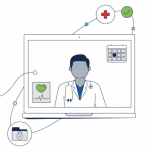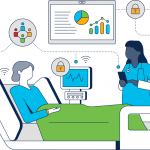What does “health” mean?
Is health just being free of illness? According to the World Health Organization, “Health is a state of complete physical, mental and social well-being and not merely the absence of disease or infirmity.” Mental well-being is foundational. And good mental health helps people “realize their potential, cope with the normal stresses of life, work productively, and contribute to their communities.”
Access to mental health services
One of the fundamental challenges in healthcare is access – access to quality, affordable care. How care was delivered used to be constrained by time and place. But the old models of care delivery are evolving. Today, high-quality, reliable, and secure video communication technology is opening up a world of opportunities. It’s increasing access to quality care and closing gaps in patient engagement and care management.
It all boils down to the simple question – can you get the services you need when and where you need them to live a healthier life?
But for mental health, the answer is often no. One in five people have a mental health issue. In Canada, one of the world’s most developed countries, only one in three people access the mental health services they need. The quality of life and financial impact is huge. In fact, in the workplace, psychological problems make up 70% of disability costs.
That’s why Cisco has partnered with Deloitte and the Centre for Addiction and Mental Health (CAMH) to use video collaboration technology, and eventually facial recognition and data analytics, to help connect mental health patients with physicians faster and help provide treatment more effectively.
Also, Cisco recently received an award being a champion of workplace mental health from the Canadian Alliance on Mental Illness and Mental Health. We received this award because of our efforts with CAMH and for making it a priority to create space for discussions around mental health in the workplace. In fact, employees now have up to $25,000 or 150 visits per calendar year to access mental health services.
Potential of telehealth across the continuum of care
Telehealth opportunities are, of course, not just limited to the specialty of mental health. Across the continuum of care, telehealth can break the boundaries that separate remote healthcare teams and enable clinicians to communicate and work collaboratively with patients and colleagues across the clinic, down the street, and around the world.
 (Source: Sg2)
(Source: Sg2)
Telespecialty
In Vietnam, patients were traveling hours away from their home to seek superior care. But, through collaboration technology, the experts at Viet Duc Hospital are now able to give guidance to regional doctors, consult on cases, and provide additional training by conducting live surgeries. With this technology, patients can receive the quality of care they need without traveling great distances.
Virtual specialty care
When it comes to breast cancer, early diagnosis is one of the most important strategies for survival. But if you live hours away from specialists and diagnosticians, the time, travel, and costs add up. This is a problem the Medical Hospital Center of Odessa, Texas, set out to solve. The hospital now works with more than 400 physicians across the U.S. to read images remotely for patients who would otherwise have no access to sub-specialists. By enabling immediate follow-up, patients and doctors can make decisions about next steps in care. Whether a patient is cleared or needs to start a treatment plan, speed matters. With Cisco networking and collaboration technology, providers now have the power to make life-changing diagnoses in real time.
Virtual primary care
Stellar Healthcare has developed a simple and cost-effective way of improving access to GP services for many patients living in the North and East London Commissioning Support Unit (NEL CSU) area. Together, they have developed a cloud-based service that enables patients to book secure video appointments with clinicians. Once the video call has been booked, the patient receives an automatically generated email containing a unique link for their appointment. The receptionist then verifies each patient’s identity before transferring them to the virtual waiting room. With shorter waiting times for appointments and the ability to speak with their GP from at home, or even from their workplace, it’s not surprising that the service is so popular with patients.
Learn more
Visit our website to learn more about what Cisco is doing to help providers deliver differentiated services where patients, clinicians, administrators, and IT work together to increase access to quality care and reduce costs.
And check out this new analyst report on how advanced collaboration technologies are helping to deliver better care.


CONNECT WITH US